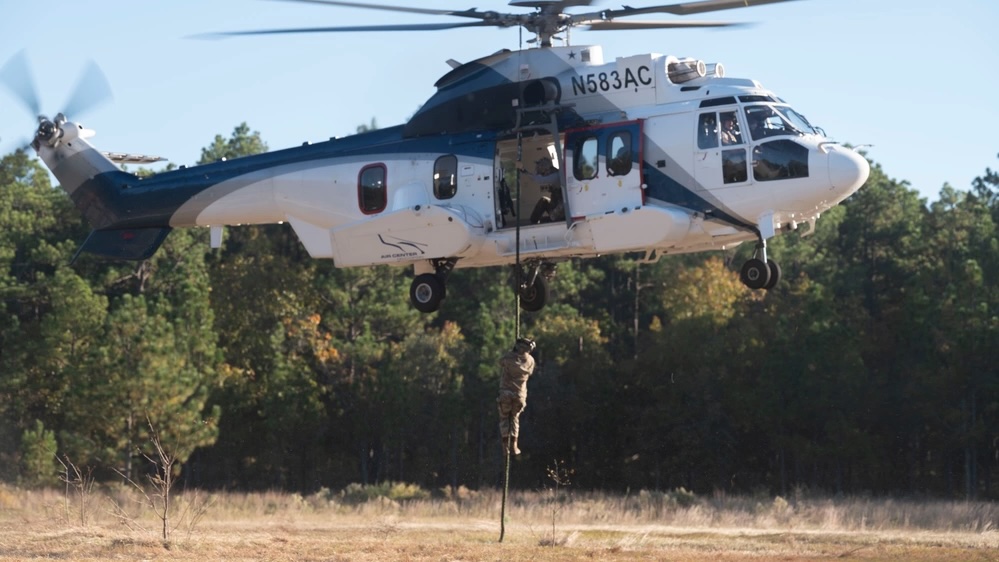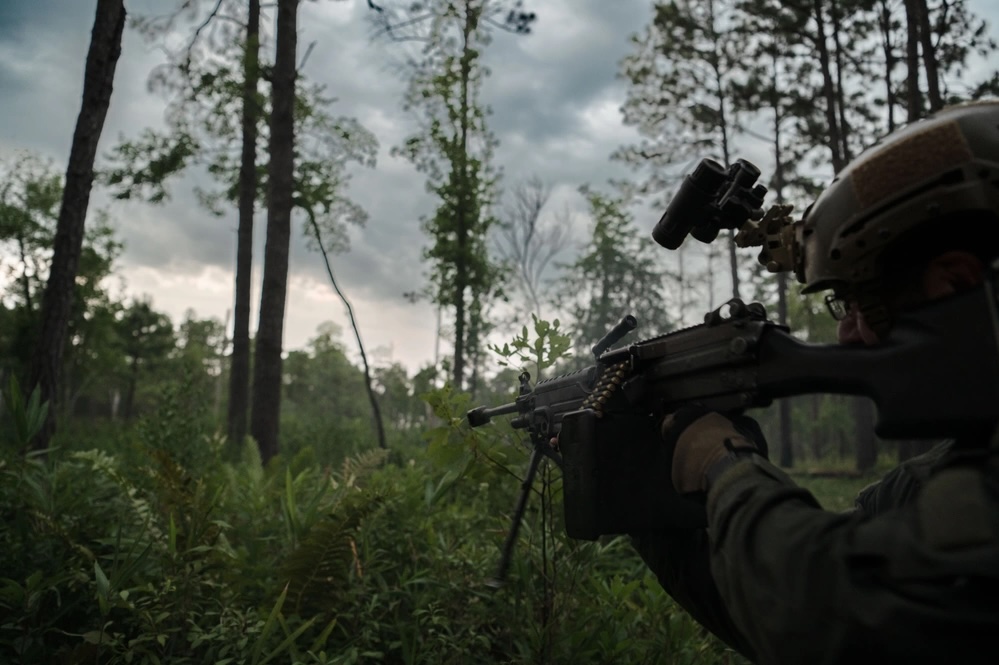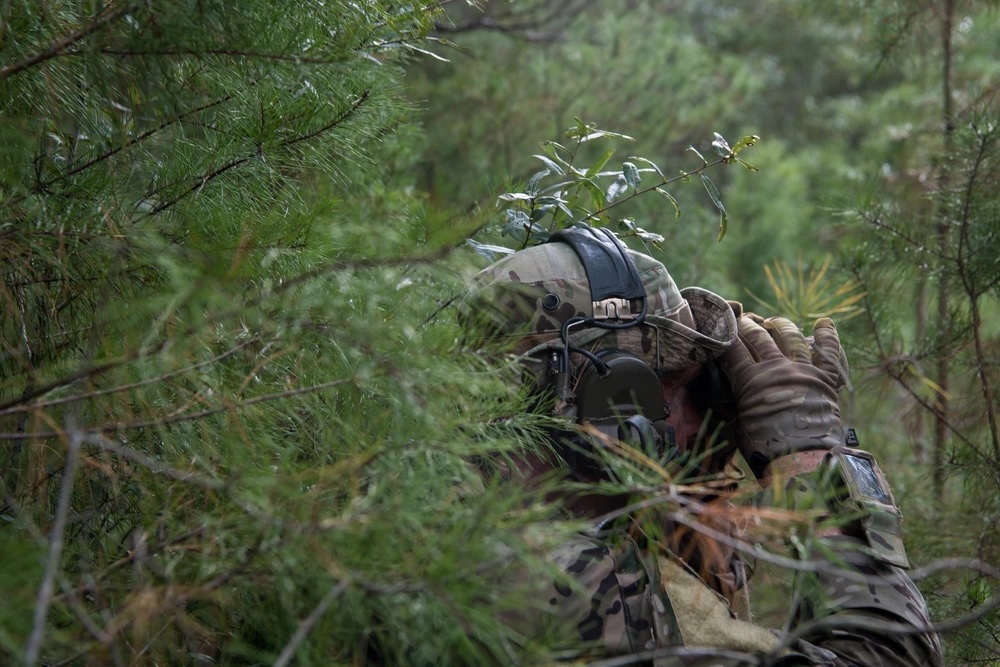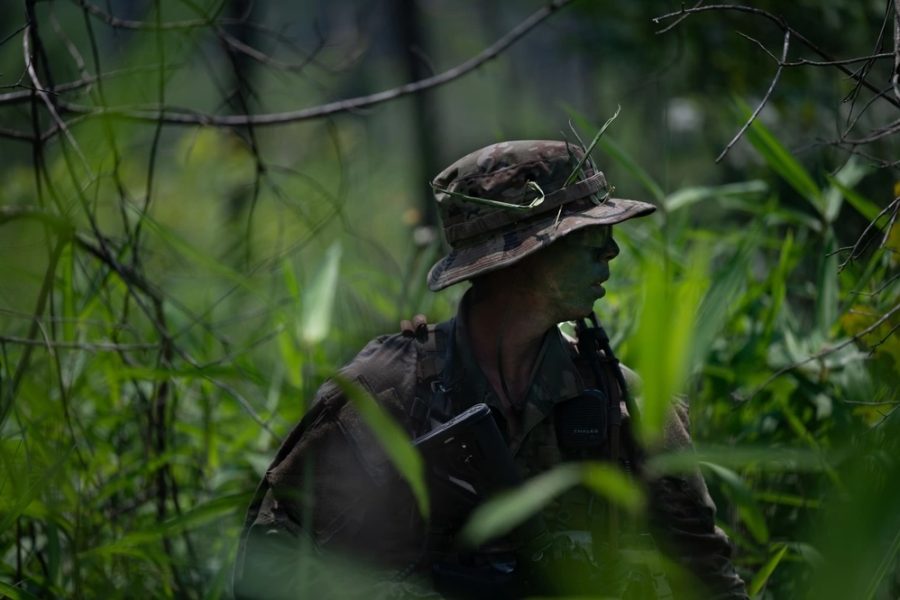Editor’s Note: This is the second in a three-part series about Special Reconnaissance. The first story can be found here, and the third can be found here.
FORT LIBERTY N.C. – Two Airmen hid in the dark, in a small hole by the side of the road running through a pine forest. Across the road, just 80 yards away, was their target: a train station they had to monitor for 24 hours for signs of enemy movement. It was bold to creep up so close, but the small ridge line into which they had dug their hide site blocked the sight lines from deeper in the woods.
The Airmen were eventually caught by the “enemy” in this training exercise, but the inconvenient ridge made clear the need for their career field: Special Reconnaissance. SR Airmen are trained in all forms of reconnaissance, from drones and cyber warfare to crawling through swamps and peering through a sniper scope. Their mission is to provide timely and accurate intelligence to airpower planners—even if they have to sneak onto an adversary’s front lawn to get it.
“Even if you have satellite imagery, you’re not going to pick up this little hill that makes a very big difference,” said Capt. Max Krasnov, a special tactics officer and training flight commander with the 352nd Special Warfare Training Squadron. The unit is based at Pope Army Airfield, N.C., home of the SR Apprentice Course.
“If you’re back 200 yards, you can see cars drive by, but that’s about the level of fidelity you can get,” Krasnov told Air & Space Forces Magazine. “If we need them to positively identify a guy with a mustache and a limp in his left leg, that is going to drive how bold they are about where they need to be.”
Sneaking up on a target requires its own set of skills, especially in this part of North Carolina, where the ground cover is sparse and a carpet of pine needles crunches underfoot.
“It sounds silly, but it is a skill just knowing how to walk through the woods in a tactical manner,” Krasnov said. “If you go hunting and sit in a tree for hours, and all of a sudden a deer appears, you’re like, ‘How did that just get there? I didn’t hear it, I didn’t see it walking up.’ Someone who’s really good, it’s almost like they can do that.”

Crawl, Walk, Run
By the time Airmen arrive at Pope for the SR and Combat Control Apprentice Courses, they already have been training to join special tactics for months. The pipeline starts with the special warfare candidate course, followed by the grueling special warfare assessment and selection course, both at Joint Base San Antonio-Lackland, Tex. Part of the goal of those courses is to put candidates through intense physical training to see if they can handle the demands of the profession.
Those who pass through assessment and selection go on to a series of schools across the country such as pre-dive swimming and water confidence, static line parachuting, freefall parachuting, and survival, evasion, resistance, and escape (SERE) training. The journey continues at the four-month apprentice course.
“The diving and jumping, that gets you to work,” Krasnov said. “This course is what you do when you get there.”
Crawl, walk, run is the name of the game. Students learn how to read a map and compass, then start navigating through the woods, a change of pace for many who have relied on GPS-enabled smartphones all their lives. They learn how to safely handle a firearm and how to shoot accurately, how to move on a battlefield and how to position themselves in a team fight. Later, they master small unit tactics, like bounding movements and ambush maneuvers.
“If you’re doing an L [-shaped ambush], you’ve got to make it an L, it can’t be, I don’t know, whatever the f— that was,” remarked one instructor after a drill. “While you’re making these big flanking movements, you’ve got to make sure you’re keeping track of where you are geographically in relation to your support-by-fire, so they can effectively support you.”
Easier said than done. Students had to yell commands through gas masks as fake artillery rounds went off around them and smoke grenades tinted the air pink and purple. An untrained observer could barely identify the camo-clad students amidst the leaves. But learning how to operate in such confused and stressful conditions is the whole objective of this course.
“Anyone can learn to program a radio—it’s not hard,” said Krasnov. “We need people who can reprogram a radio when they are cold, hungry, haven’t slept in two or three days and are in the middle of a firefight.”

Bread-and-butter
Usually about a quarter of the students at Pope aim to join SR, while the rest hope to become combat controllers (CCTs), who are experts at coordinating aircraft with ground operations. The students train on many skills together, such as land navigation and small-unit tactics, but they split up for skills specific to each career field. The SR Airmen learn the basics of weather observation, intelligence processing and reporting, surveillance and reconnaissance equipment and techniques, long-range shooting with the M110 rifle, and stalking lanes, where Airmen build ghillie suits, using grass or other forms of ground cover camouflage, and learn to move around undetected.
“It looks super cool,” said Tech Sgt. J, an SR instructor whose full name was withheld for security reasons. “And then you do it for the first time and you realize that it is miserable, especially if it’s really hot out. People don’t realize how hot ghillie suits are.”
In the stalking lanes, J explained, students have to sneak up to a truck full of instructors, close enough so they can identify the letter on a placard one of them is holding up—all while evading the trained eyes of the instructors. It is a difficult task, but an essential one for sneaking deep into enemy territory, which SR Airmen may have to do if satellites are offline or the airspace is too heavily defended for aerial surveillance.
“Even if SR Airmen use cyber or electronic warfare, they still have to get to a location the enemy doesn’t want them to be, without them knowing,” said Krasnov.
The SR students learn the basics of operating small unmanned aerial systems, starting with tiny quadcopters about the size of a dinner plate. Though easy to fly, operating them effectively in an undercover military operation requires deep understanding, such as how high to fly to remain undetected, counter-drone techniques adversaries might use to evade drones’ thermal sensors, safe operating range and timelines, and how many spare batteries to bring for a mission.
The apprentice course is really only a starting point: graduates will continue their training for another six more months at a special tactics training squadron. Advanced SR skills include operating fixed-wing drones and top-secret cyber and electronic warfare tools.

Best Friends
The apprentice course ends with a week-long final training exercise where CCT and SR students demonstrate the skills they learned over the past four months. The exercise often begins with students parachuting into a simulated contested environment, after which they must establish a forward operating base and pursue follow-on missions, like striking a target or capturing an airfield to land a C-130 or to airdrop troops and supplies.
The exercise gives the students a chance to practice the basics of their respective career fields: CCT students may establish and operate an airfield or call in air support, while SR students may have to sneak up on a target and gather intelligence for an ambush. The exercise ends with a 15-mile ruck march back to base.
Graduation is a hard-won moment for both students and instructors. “These students, within a year they’re going to be on team with all of the instructors’ best friends,” Krasnov said. So instructors are incentivized to do a good job. “One, the instructors want to make sure they’re not going to get their friends killed. And two, all their friends know that we are responsible for the quality of the students. So they don’t want their buddies to rag on them for producing bad students.”
